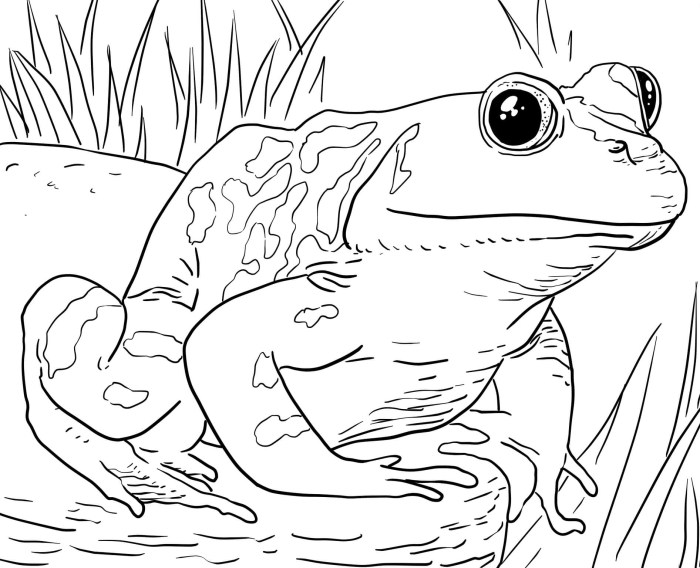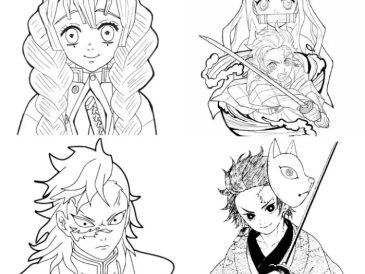Popularity and Trends of Free Animal Coloring Books

Free animal coloring books – Free printable animal coloring books enjoy significant popularity, driven by their accessibility and versatility. They cater to a broad audience, offering a readily available creative outlet for individuals of all ages and skill levels. This popularity is further fueled by the ongoing trends in digital media and the readily available online resources.The enduring appeal of animal coloring pages is undeniable.
These resources offer a simple yet engaging activity, fostering creativity and relaxation. The accessibility of free options contributes significantly to their widespread use.
Popular Animal Themes
The most popular animal themes in free printable coloring books reflect a combination of cultural familiarity and inherent visual appeal. Commonly featured animals include domestic pets like cats and dogs, wild animals like lions, tigers, and elephants, and fantastical creatures like unicorns and dragons. Specific trends can vary based on current events or popular media, but these consistently remain favorites.
For instance, a popular animated movie featuring a specific animal may temporarily boost the popularity of coloring pages featuring that animal.
Demographics of Users
Free animal coloring books appeal to a wide demographic. Parents frequently utilize them as educational tools for young children, promoting fine motor skills, hand-eye coordination, and color recognition. Adults also utilize them as stress relievers and creative outlets, participating in the growing trend of adult coloring books. Educators and therapists may also incorporate them into lesson plans or therapeutic activities.
Essentially, the accessibility of free options makes them a versatile resource across age groups and contexts.
Many enjoy the relaxing pastime of coloring, and free animal coloring books are readily available online. For a more extensive and convenient selection, consider exploring the digital realm with readily available free coloring book apps ; these often feature a wider variety of animal designs than you’ll find in printable books. Whether you prefer physical pages or digital screens, the creative possibilities with free animal coloring books are endless.
Comparison to Paid Options
While paid coloring books offer higher-quality printing and sometimes unique designs or themes, free printable options provide immediate access and a wider variety of choices. Paid versions often focus on specific niches or artistic styles, whereas free options cater to a broader range of preferences. The cost-free nature of printable options makes them an attractive alternative for individuals on a budget or those seeking a quick and easy creative activity.
The difference often lies in the level of detail, artistic style, and overall presentation, with paid versions typically showcasing more sophisticated designs and higher-quality paper stock. However, the accessibility and ease of access to free options make them a strong competitor in the market.
Types and Styles of Free Animal Coloring Books
Free animal coloring books offer a diverse range of options catering to various ages and interests. The variety in animal species depicted and the artistic styles employed significantly impact the overall appeal and usability of these resources. This section will explore the different categories and styles commonly found in freely available animal coloring books.
The categorization of these books is multifaceted, encompassing the types of animals featured and the artistic techniques used to portray them. This allows for a broad spectrum of choices, from simple line drawings suitable for young children to more intricate designs that challenge older children and adults.
Animal Species Categorization
Free animal coloring books are frequently organized around specific animal categories. This makes it easier for users to find books featuring their favorite animals or those suitable for a particular learning objective.
Common categories include farm animals, wild animals, and marine animals. Farm animal coloring books might feature cows, pigs, sheep, chickens, and horses, often depicted in a relatively simple and cartoonish style. Wild animal coloring books might include lions, tigers, bears, elephants, and monkeys, potentially with more realistic or stylized depictions. Marine animal coloring books will feature creatures like dolphins, whales, sharks, sea turtles, and various fish, often showcasing the vibrant colors and unique features of underwater life.
Some books may also blend categories, such as a book featuring both farm and wild animals.
Art Styles in Animal Coloring Books
The artistic style significantly influences the complexity and appeal of a coloring book. Different styles cater to various skill levels and aesthetic preferences.
Realistic styles aim for accurate representation of animal anatomy and features, often involving detailed shading and texture. Cartoonish styles employ simplification and exaggeration for a fun and playful look. Simple styles use basic shapes and lines, ideal for younger children developing their fine motor skills. Abstract styles might deconstruct animal forms into patterns and shapes, appealing to those who enjoy more creative and interpretive coloring experiences.
Some books might even blend styles, for instance, combining realistic animal features with a cartoonish overall presentation.
Examples of Free Animal Coloring Books
| Animal Type | Art Style | Source URL (Example – May not be functional) |
|---|---|---|
| Farm Animals | Cartoonish | Example.com/farm-animals |
| Wild Animals | Realistic | Example.com/wild-animals |
| Marine Animals | Simple | Example.com/marine-animals |
| Jungle Animals | Stylized | Example.com/jungle-animals |
Illustrative Examples of Free Animal Coloring Books
Free animal coloring books offer a diverse range of styles and artistic approaches, catering to different age groups and interests. The examples below showcase the variety available online, highlighting their unique features and target audiences. Careful consideration of the artistic style, color palettes, and line complexity is crucial in determining the suitability of a coloring book for its intended user.
Three distinct examples illustrate the breadth of free animal coloring books available. Each possesses unique characteristics in terms of artistic style, target audience, and complexity.
Detailed Descriptions of Three Free Animal Coloring Books
The following descriptions detail three distinct free animal coloring books, emphasizing their unique qualities and intended audiences. The analysis considers the illustrations’ color palettes, line styles, and artistic approach.
Example 1: “Whimsical Wildlife” This coloring book features cartoonish animals with simplified, bold Artikels and bright, saturated colors. The style is reminiscent of children’s illustrations, employing a limited color palette that includes primary colors and some secondary shades. Line styles are thick and consistent, making it easy for young children to color within the lines. The overall artistic approach is playful and engaging, ideal for preschoolers and early elementary school children.
Animals depicted might include a smiling lion with a fluffy mane, a playful elephant with oversized ears, and a cheerful giraffe with brightly colored spots.
Example 2: “Realistic Rainforest” This coloring book showcases detailed and realistic depictions of rainforest animals. The illustrations feature intricate details, such as fur texture and feather patterns, and utilize a more nuanced color palette. The line styles are thin and varied, reflecting the complexity of the animals’ anatomy. The artistic approach aims for realism and accuracy, appealing to older children, teenagers, and adults who enjoy detailed coloring projects.
Examples could include a jaguar with its spotted coat meticulously rendered, a toucan with vibrant, detailed plumage, and a sloth hanging from a branch with realistically depicted fur.
Example 3: “Simple Farm Friends” This coloring book presents simple, child-friendly depictions of farm animals. The illustrations are characterized by large, easily colorable shapes and minimal details. The color palette is muted and pastel-toned, creating a calming and gentle visual experience. Line styles are thick and uncomplicated, perfect for young children who are still developing their fine motor skills. The artistic approach prioritizes simplicity and ease of use, making it suitable for toddlers and preschoolers.
Examples include a friendly cow with large, easily colored patches, a pig with a simple curly tail, and a sheep with soft, rounded features.
Comparative Table of Free Animal Coloring Books
This table summarizes the strengths and weaknesses of the three example coloring books, allowing for a direct comparison of their features and target audiences.
| Feature | Whimsical Wildlife | Realistic Rainforest | Simple Farm Friends |
|---|---|---|---|
| Target Audience | Preschool – Early Elementary | Older Children, Teenagers, Adults | Toddlers – Preschool |
| Artistic Style | Cartoonish, Simplified | Realistic, Detailed | Simple, Child-Friendly |
| Color Palette | Bright, Saturated | Nuanced, Varied | Muted, Pastel |
| Line Style | Thick, Consistent | Thin, Varied | Thick, Uncomplicated |
| Strengths | Easy for young children, engaging | Challenging and rewarding, detailed | Simple and accessible for toddlers |
| Weaknesses | May be too simple for older children | Can be frustrating for younger children | May lack complexity for older children |
Impact and Benefits of Free Animal Coloring Books

Free animal coloring books offer a surprisingly wide range of benefits, impacting children’s development and enriching the broader educational landscape. Their accessibility, coupled with the engaging nature of animal imagery, creates a powerful tool for learning and growth. The positive effects extend beyond simple entertainment, fostering crucial skills and promoting well-being.The readily available nature of free animal coloring books contributes significantly to children’s development in several key areas.
Coloring itself helps refine fine motor skills, improving hand-eye coordination, dexterity, and grip strength. The creative process of choosing colors and filling spaces encourages self-expression and imagination, allowing children to explore their artistic abilities without pressure or financial constraints. Furthermore, the calming, repetitive nature of coloring can provide a valuable stress reliever, helping children relax and focus.
The act of choosing colors and bringing the animal images to life can also be a boost to self-esteem, as children experience a sense of accomplishment upon completion of their artwork.
Benefits for Children’s Development
Free animal coloring pages offer a multitude of developmental advantages for children. The act of coloring strengthens fine motor skills, essential for writing and other manipulative tasks. Children develop hand-eye coordination as they carefully guide the crayon or colored pencil within the lines. The selection of colors and patterns fosters creativity and self-expression, allowing children to showcase their unique personalities and preferences.
The focused attention required during coloring also enhances concentration and reduces stress. Many children find the repetitive nature of coloring to be soothing and calming, providing a valuable outlet for emotional release. Finally, the sense of accomplishment upon completing a coloring page boosts self-esteem and confidence.
Educational Applications of Free Animal Coloring Books
Free animal coloring books can be effectively integrated into various educational settings. In preschools and kindergartens, they can be used to teach color recognition, animal names, and basic shapes. Teachers can incorporate them into lessons on habitats, animal diets, or life cycles. Older children can use them for creative writing prompts, encouraging storytelling based on the animals depicted.
In special education settings, coloring can be a therapeutic tool to improve fine motor skills and reduce anxiety. The free accessibility ensures that these resources are available to all students, regardless of socioeconomic background. For example, a teacher could use a coloring page featuring different types of birds to introduce a lesson on bird identification and habitats.
Following the coloring activity, the children could engage in a discussion about the different bird species, their unique characteristics, and where they live.
Impact on the Art and Education Community, Free animal coloring books
The widespread availability of free animal coloring books significantly impacts the art and education community. It democratizes access to art supplies and creative activities, particularly benefiting children from low-income families who may not otherwise have access to such resources. This increased access fosters a broader appreciation for art and creativity, potentially inspiring a new generation of artists. Furthermore, the free availability of these resources reduces the financial burden on schools and educators, allowing them to allocate resources to other essential educational materials.
The ease of access also encourages more frequent use, thereby enhancing the learning experience and promoting creativity in a more accessible and affordable manner. For example, a school library could provide free animal coloring books to students, encouraging them to engage in creative activities during breaks or free time. This could lead to increased student engagement and a more positive learning environment.




